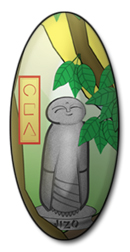On The Way: The Daily Zen Journal
Treatise on Contemplating Mindfulness
Bodhidharma
Huike asked: If there are people intent on seeking the path of Enlightenment, what method should they practice, what method is most essential and concise?
Bodhidharma answered: Let them just contemplate mind—this one method takes in all practices and is indeed essential and concise.

Huike asked: How can one method take in all practices?
Bodhidharma answered: Mind is the root of the myriad phenomena. All phenomena are born from mind. If you can completely comprehend mind, the myriad practices are complete. It is like a great tree: all the branches and flowers and fruits grow based on the root.
The tree grows only if the root survives. If the root is cut, the tree is sure to die. If you cultivate the Path by comprehending mind, you save effort and success is easy. If you cultitvate the Path without comprehending mind then you waste effort, and there is no benefit. Thus we know that all good and evil come from one’s own mind. If you seek outside of mind, it is impossible.
Huike asked: Why is contemplating mind called complete comprehension?
Bodhidharma answered: When the great bodhisattvas practice profound perfection of transcendental wisdom, they comprehend that the four great elements and the five clusters are fundamentally empty and selfless. They see that there are two different kinds of activity initiated by inherent mind: pure states of mind and defiled states of mind.
Pure mind is the mind of undefiled True Thusness. Defiled mind is the mind of ignorance. These two kinds of mind are both there of themselves from the beginning. Though everything is produced by the combinations of temporary causes, pure mind always takes delight in good causes, while defiled mind is constantly thinking of evil deeds.
If True Thusness is aware of itself and, being aware, does not accept defilement, then this is called being a sage. This enables one to leave all suffering far behind and experience the bliss of nirvana. If you follow along with defilement and create evil, you are subject to its bondage—this is called being an ordinary person
Then you are submerged in the triple world, subject to all kinds of suffering. Why? Because those defiled states of mind block off the body of True Thusness.
The Ten Stages Sutra says:
“Within the bodies of sentient beings there is an indestructible enlightened nature. It is like the orb of the sun: its body is bright and round and full and vast without limit. Because it is covered by the black clouds of the five clusters, it is like a lamp placed in a jar so that the light cannot appear.”
The Nirvana Sutra says:
“All sentient beings have buddha-nature. Because it is covered over by ignorance, they are not set free. Buddha-nature is enlightenment. When it is aware of itself and its awareness is completely illuminated apart from what covers it, this is called liberation.”
Thus we know that all forms of good have enlightenment as their root: the tree of all merits appears based on the root of enlightenment. The fruit of nirvana is formed from this. Contemplating mind like this can indeed be called complete comprehension.
Huike also asked: You have just stated that all the merits of the enlightenment nature of True Thusness depend on enlightenment as their root. I wonder, what is the root for all the forms of evil of the mind of ignorance?
Bodhidharma answered: Though the mind of ignorance has eighty four thousand afflictions, sentiments, desires, and uncountable evils, in essence, they all have the three poisons as their root. The three poisons are greed, anger, and ignorance. The mind of these three poisons of itself inherently includes all forms of evil.
It is like a great tree: though there is one root, the branches and leaves it gives life to are numberless. Each of the three poisons as a root gives birth to evil deeds even more prolifically. These three poisons become three poisons from a single fundamental essence.
They are sure to manifest the six sense faculties, also called the six thieves. The six thieves are the six consciousnesses: they are called six thieves because they go in and out via the sense faculties becoming attached to the myriad objects and forming evil deeds, which block off the body of True Thusness.
All sentient beings are plunged into ignorance and confusion by these three poisons and six thieves. Body and mind sink down into birth and death and revolve through the six planes of existence, receiving all kinds of suffering and affliction. It is like a river that starts from a small spring: since the flow from the source is unbroken, it can extend its waves for thousands of miles. If a person cuts off the root source, then the many streams all stop.
Those who seek liberation must be able to transform the three poisons into the three forms of pure discipline, and transform the six thieves into the six paramitas, thereby spontaneously leaving behind forever all forms of suffering.
Huike asked: The three poisons and the six thieves are vast and limitless: how can one avoid their infinite pain by just contemplating mind?
Bodhidharma answered: The karmic rewards of the triple world are just products of mind. If you can completely comprehend mind within the triple world, you escape the triple world.
The triple world corresponds to the three poisons. Greed corresponds to the realm of desire, anger to the realm of form, and ignorance to the formless realm. From these three poisons the mind assembles all the karmic rewards of evil and forms the six planes of samsara. Thus the three poisons are called the triple world.
Bodhidharma (440-533)
Source Zen Dawn – Early Zen Texts from Tun Huang- trans by J. C. Cleary 1986





The beginning of this piece sounds like Bodhidharma talking, well, perhaps how we imagine he might sound based on the legend of Bodhidharma that we have read.
What little we know of him sitting in front of the wall and not responding to Huike until he took extreme measures to show his sincerity indicates someone of profound depth and experience. When compared with other translations one wonders if the entirety of this is from him or later accruals.
This particular writing discovered in the 12th century in the Tun Huang caves represents some of the earliest surviving records of Buddhism. There are records translated which are attributed to Bodhidharma, but there is only agreement that the Outline of Practice clearly can be associated with him.
In essence, Bodhidharma’s teaching is rather bare-bones,
“Let them just contemplate mind—this one method takes in all practices and is indeed essential and concise.”
Those of us in times far removed from a master are relying on faithful representation of the heart of their teachings. Once you get into explaining how things come to be in the world, you add layers of intellect that feel like things you are going to need to shed at some point or other.
So sifting through sutras or early writings requires some spiritual discernment. While the three poisons and six thieves are striking images, there were many questions the Buddha would not answer as they “tended not to edification.” What is essential to the Buddha’s message and what has been added on?
I have included a link to another translation of this same piece to illustrate the subtleties involved in translation and to give another flavor to this teaching.
All my best,
Elana, Scribe for Daily Zen